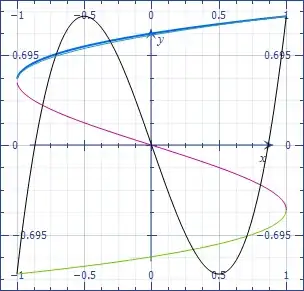The resolution of the cubic equation is known to have a "casus irreductibilis" such that the computation of real roots requires an excursion in the complex numbers. The usual formulas involve trigonometric functions and essentially amount to the evaluation of
$$\cos\left(\frac{\arccos x+2k\pi}3\right)$$ which solves the angle trisection problem.
I would like to know if other formulations are known, which might be more computationally efficient.
The hyperbolic counterpart is
$$\cosh\left(\frac{\text{argcosh }x}3\right)=\cosh\left(\frac{\log\left(x+\sqrt{x^2-1}\right)}3\right)=\frac12\left(\sqrt[3]{x+\sqrt{x^2-1}}+\sqrt[3]{x-\sqrt{x^2-1}}\right).$$
Update:
By simple trigonometry, the function is in fact the three-branched inverse of the cubic $4x^3-3x$.
If a good approximate solution can be estimated, maybe a few Newton's iterations can quickly polish. The blue branch is close to
$$\sqrt{\dfrac{x+1}8}+\frac12.$$
